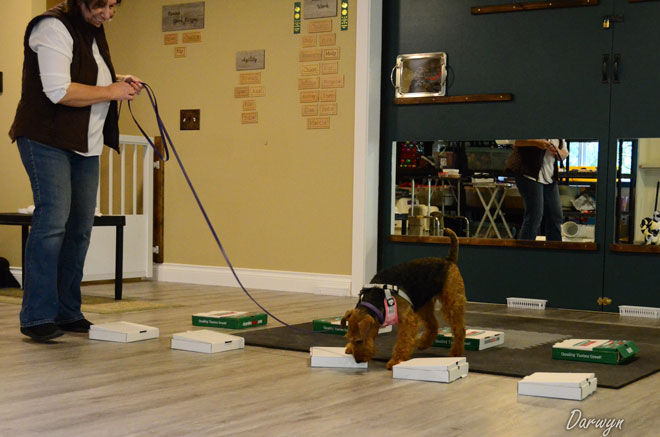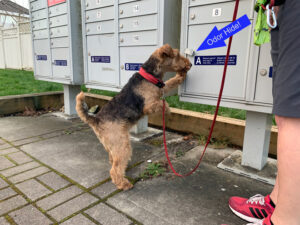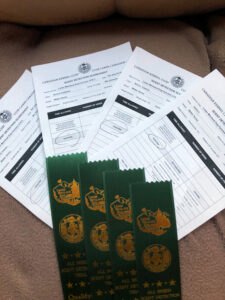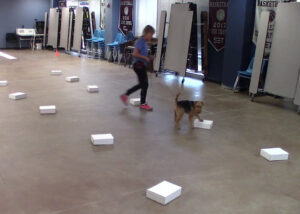Larisa has been actively participating in structured nose work training since 2018, and successfully titled 2 of her Welsh Terriers in competitions. Both dogs are Grand Champions and Terrier Group 1st winners — so they aren’t just pretty, and enjoyable companions, but they are smart too! A few other Darwyn Welsh Terrier Owners have also successfully titled their Welsh Terriers in Nose Work / Scent Detection events.
Over the years, Larisa has worked with quite a few Welsh Terriers, and watched many dogs of all types of breeds, train in Nose Work. Every one has enjoyed it! The dogs prove time and again that they love to problem solve with their scenting abilities, especially in this structured approach. The owners find it fun and easy to do. They enjoy seeing how much fun the dogs are having, and experience how easy it is to practice.
From my trainers website which summarizes this so nicely:
“Dogs naturally use their noses to scan their environment and understand it but they rarely get to use their nose the way they want to in their daily life with people. Imagine how they feel when they realize that, with nose work, they get ‘paid’ to search and they get to ‘lead the dance!’ This sport uses that hunting behaviour and mimics professional scent detection work.
From exuberant puppies to creaky elders, it’s truly an all-encompassing dog sport. It teaches focus in youngsters, burns mental and physical energy and improves the lives of dogs with cognitive age issues.
It is also suitable for fearful or ‘dog reactive’ dogs because searches are done in a controlled environment with only one dog working at a time. “
From the AKC about Scent Work:
“Fascinating fact: Dogs have a sense of smell that’s between 10,000 and 100,000 times more acute than ours! The sport of Scent Work celebrates the joy of sniffing, and asks a dog to sniff to their heart’s content; turning your dog’s favorite activity into a rewarding game. It is a terrific sport for all kinds of dogs, and is a wonderful way to build confidence in a shy dog.
In so many dog sports the handler is in control but this isn’t true in Scent Work. Neither the dog nor handler knows where the target odor is hidden. The handler has to rely on the dog, and follow the dog’s nose to success. In Scent Work, it is the canine who is the star of the show.”
With a structured training approach, the more you train, the more you realize there is more to learn. The dogs develop problem solving skills, as well as learn how to handle different stresses. We also develop skills — we learn to better read our dogs, develop some problem solving, learn about our own levels of stresses, and improve handling techniques.
Playing Nose Work games can be as simple as hiding cookies in couch cushions. But, with a structured training approach, it is so much more interesting, to both the owner and the dog.
This helps to have engaging fun with our dogs, in a relatively easy way, that the dogs truly love doing. I know this for a fact. The only time my dogs wear a harness is when I play Nose Work games … and when that harness comes out, the dogs put on a big smile and get very excited. Very clear indications of how much their enjoy this activity.
Peggy McCallum's boy Rowan finding an 'Exterior Search'
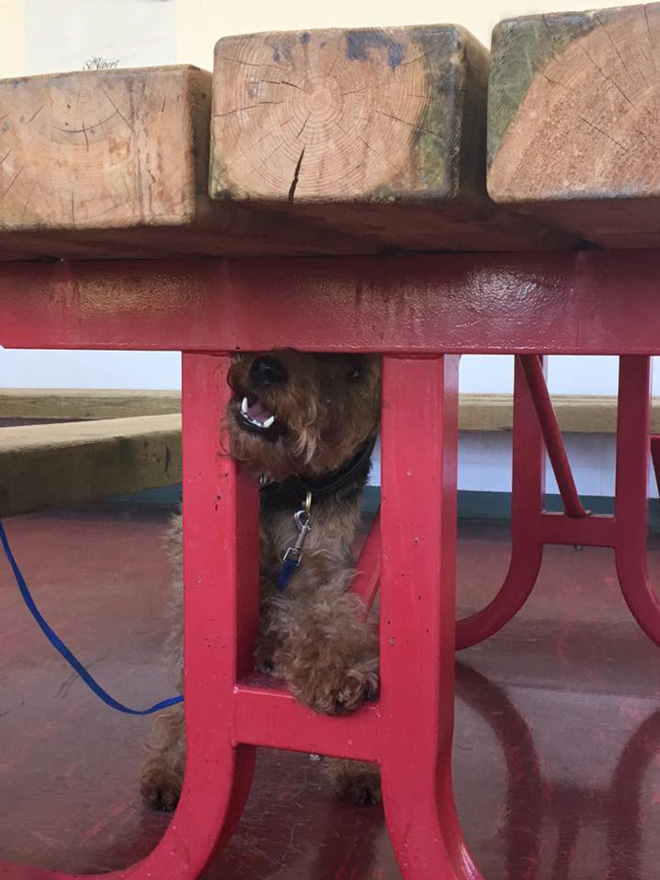
Rowan’s titles defined:
Some Useful Links
- National Association of Canine Scent Work (NACSW)
- Sporting Detection Dogs Association (SDDA)
- CKC (Canadian Kennel Club) – Scent Detection
- AKC (American Kennel Club) – Scent Work
- Nosework Passion (Larisa’s primary trainer; Brenda Cox, who offers online classes)
- ABC Games
- Find a NACSW trainer
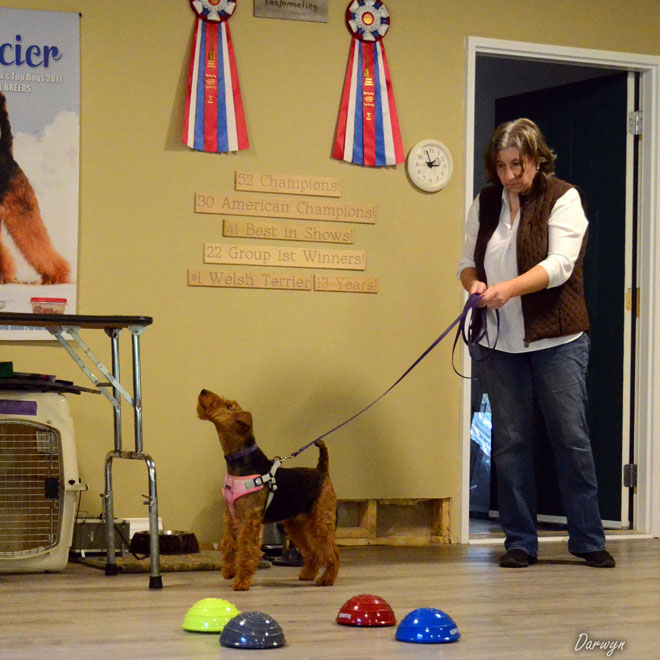
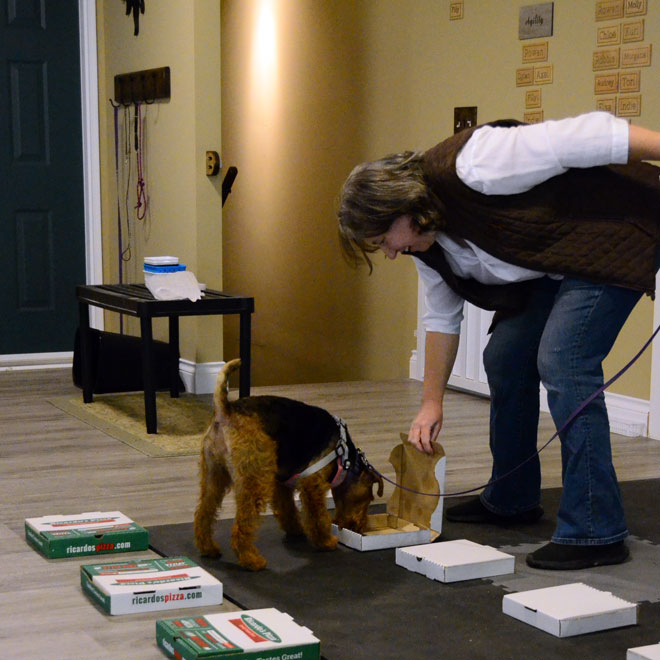
Thoughts from Darwyn Welsh Terrier owners:
“I like that once your dog is trained, you can ‘play’ anywhere. You don’t need a lot of equipment. I keep a couple ‘hides’ (re: odor kit) in my car and when I have a little time en route somewhere, I can stop just about anywhere and we can practice. “
Laurie Harding; owner of Filly
Champion Darwyn’s Flying Filly; RATS,NS,CA,TD-CH, SDO, CGN, V-B
RATS: Barn Hunt, Senior Level (successful qualification runs at Masters Level)
NS: Novice Sprinter (100 meter dash)
CA: Chase Ability (600 meter lure coursing)
TD-CH: Trick Dog Champion
SDO: Scent Detection Open Level
CGN: Canine Good Neighbour
V-B: Versatility Bronze Level
“Nose work has been the best thing I have done with my dog. It has helped her build confidence, stay calm and focused. It is the ultimate team sport contributing to bonding us together. I have learned so much with this sport on how to read my dog, the wind and it has built the wonderful communication that we have together. “
Lisa Patton; owner of Chanté
Champion Darwyn’s Enchanté; BCAT, CGC, TD-CH, RATO, AKC Scent Detection Novice
Some science behind dogs incredible noses
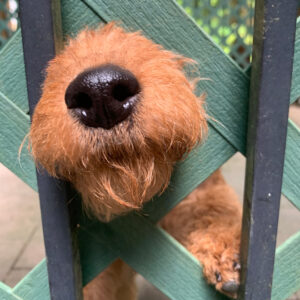
Ever noticed those slits at the sides of a dog’s nose? Why do dogs have them?
Once again, nature proves her elegance in the design of our dogs. When we humans inhale and exhale, air comes in the same way it goes out. Any smells that come in through our mouths are forced out as we exhale, if we exhale out our mouths.
When a dog exhales through his nose, however, the exhaled air is released through those slits and off to the side so that nice, smelly air going into the dog’s nostrils doesn’t get diluted with the outgoing air. Put another way, the slits allow the dog to avoid smelling what he just exhaled.
The slits help the dog hold scent particles in the nostrils even as exhaled air passing out the slits creates a swirling air turbulence allowing interesting odors to be inhaled directly into the centre of each nostril. Since dogs breathe faster when trying to sniff a certain smell, they widen their nostrils to pull in more air which makes it possible for a dog searching for smells to have a steady stream of air coming in for up to 40 seconds, maybe even longer.
The slits also allow dogs to wiggle each nostril independently which gives them the ability to know which nostril a smell entered. This is how a dog can pinpoint where a smell is coming from, and why a dog searching for smells on the ground will weave back and forth as he follows a trail.
We all know the superb smelling abilities of dogs, but let’s use an analogy between scent and sight to really put it into perspective: If our eyes were our nose, what we as humans can see at a third of a mile, our dog can see more than 3,000 miles away and still see as well.
And … there are even more ways that our dogs “smell” including special parts of their mouths and brains.
Just wow!
